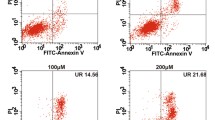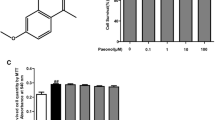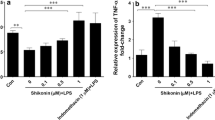Abstract
Resveratrol (trans-3,4′-trihydroxystilbene), a natural phytoalexin, possesses anti-inflammatory, anti-proliferative, and immunomodulatory properties and has the potential for treating inflammatory disorders. The present study was designed to investigate the effects of resveratrol on TNF-α-induced inflammatory cytokines production of IL-1β and MMP3 in Rheumatoid arthritis (RA) Fibroblast-like synoviocytes (FLS) and further to explore the role of PI3K/Akt signaling pathway by which resveratrol modulates those cytokines production. The levels of IL-1β, MMP-3 in cultural supernatants among groups were measured by enzyme-linked immunosorbent assay. Messenger RNA expression of IL-1β and MMP-3 in RA FLS was analyzed using a reverse transcription-polymerase chain reaction. Western blot analysis was used to detect proteins expression in RA FLS intervened by resveratrol. Resveratrol inhibited both mRNA and proteins expressions of IL-1β and MMP-3 on RA FLS in a dose-dependent manner. Resveratrol also decreased significantly the expression of phosphorylated Akt dose dependently. Activation of PI3K/Akt signaling pathway exists in TNF-α-induced production of IL-1β and MMP3 on RA FLS, which is hampered by PI3K inhibitor LY294002. Immunofluorescence staining showed that TNF-α alone increased the production of P-Akt, whereas LY294002 and 50 μM resveratrol suppressed the TNF-α-stimulated expression of P-Akt. Resveratrol attenuates TNF-α-induced production of IL-1β and MMP-3 via inhibition of PI3K-Akt signaling pathway in RA FLS, suggesting that resveratrol plays an anti-inflammatory role and might have beneficial effects in preventing and treating RA.





Similar content being viewed by others
References
Noss EH, Brenner MB (2008) The role and therapeutic implications of fibroblast-like synoviocytes in inflammation and cartilage erosion in rheumatoid arthritis. Immunol Rev 223:252–270
Feldmann M (2001) Pathogenesis of arthritis: recent research progression. Nat Immunol 2:771–773
Zhang HG, Wang Y, Xie JF, Liang X, Liu D, Yang P et al (2001) Regulation of tumor necrosis factor alpha-mediated apoptosis of rheumatoid arthritis synovial fibroblasts by the protein kinase Akt. Arthr Rheum 44:1555–1567
Reedquist KA, Ludikhuize J, Tak PP (2006) Phosphoinositide 3-kinase signalling and FoxO transcription factors in rheumatoid arthritis. Biochem Soc Trans 34:727–730
Morel J, Audo R, Hahne M et al (2005) Tumor necrosis factor-related apoptosis-inducing ligand (TRAIL) induces rheumatoid arthritis synovial fibroblast proliferation through mitogen-activated protein kinases and phosphatidylinositol 3-kinase/Akt. J Biol Chem 280(16):15709–15718
Kim G, Jun JB, Elkon KB (2002) Necessary role of phosphatidylinositol 3-kinase in transforming growth factor beta-mediated activation of Akt in normal and rheumatoid arthritis synovial fibro blasts. Arthr Rheum 46(6):1504–1511
Pap T, Franz JK, Hummel KM et al (2000) Activation of synovial fibroblasts in rheumatoid arthritis: lack of Expression of the tumour suppressor PTEN at sites of invasive growth and destruction. Arthr Res 2(1):59–64
Xu H, He X, Yang X et al (2007) Anti-malarial agent artesunate inhibits TNF-α induced production of proinflammatory cytokines via inhibition of NF-κB and PI3kinase/Akt signal pathway in human rheumatoid arthritis fibroblast-like synoviocytes. Rheumatology 46:920–926
Dhaouadi T, Sfar I, Abelmoula L et al (2007) Role of immune system, apoptosis and angiogenesis in pathogenesis of rheumatoid arthritis and joint destruction, a systematic review. Tunis Med 85:991–998
Harris SJ, Foster JG (2009) Ward SG. PI3K isoforms as drug targets in inflammatory diseases: lessons from pharmacological and genetic strategies. Curr Opin Investig Drugs 10:1151–1162
Marone R, Cmiljanovic V, Giese B et al (2008) Targeting phosphoinositide 3-kinase: moving towards therapy. Biochim Biophys Acta 1784(1):159–185
Ameriks MK, Venable JD (2009) Small molecule inhibitors of phosphoinositide 3-kinase (PI3K) delta and gamma. Curr Top Med Chem 9(8):738–753
Harikumar KB, Aggarwal BB (2008) Resveratrol: a multitargeted agent for age-associated chronic diseases. Cell Cycle 15:1020–1035
Fröjdö S, Cozzone D, Vidal H et al (2007) Resveratrol is a class IA phosphoinositide 3-kinase inhibitor. Biochem J 406(3):511–518
Byun HS, Song JK, Kim YR et al (2008) Caspase-8 has an essential role in resveratrol-induced apoptosis of rheumatoid fibroblast-like synoviocytes. Rheumatology 47:301–308
Nakayama H, Yaguchi T, Yoshiya S et al (2012) Resveratrol induces apoptosis MH7A human rheumatoid arthritis synovial cells in a sirtuin 1-dependent manner. Rheumatol Int 32:151–157
Tang LL, Gao JS, Chen XR et al (2006) Inhibitory effect of resveratrol on the proliferation of synoviocytes in rheumatoid arthritis and its mechanism in vitro. Zhong Nan Da Xue Xue Bao Yi Xue Ban 31:528–533
Tian J, Gao J, Chen J, Li F et al (2010) Effects of resveratrol on proliferation and apoptosis of TNF-alpha induced rheumatoidarthritis fibroblast-like synoviocytes. Zhongguo Zhong Yao Za Zhi 35:1878–1882
Arnett FC, Edworthy SM, Bloch DA et al (1988) The American Rheumatism Association 1987 revised criteria for the classification of rheumatoid arthritis. Arthr Rheum 31:315–324
McInnes IB, O’Dell JR (2010) State-of-the-art: rheumatoid arthritis. Ann Rheum Dis 69:1898–1906
Bongartz T, Sutton AJ, Sweeting MJ et al (2006) Anti-TNF antibody therapy in rheumatoid arthritis and the risk of serious infections and malignancies: systematic review and meta-analysis of rare harmful effects in randomized controlled trials. JAMA 295:2275–2285
Khanna D, Sethi G, Ahn KS et al (2007) Natural products as a gold mine for arthritis treatment. Curr Opin Pharmacol 7:344–351
Elmali N, Baysal O, Harma A et al (2007) Effects of resveratrol in inflammatory arthritis. Inflammation 30:1–6
Xuzhu G, Komai-Koma M, Leung BP et al (2012) Resveratrol modulates murine collagen-induced arthritis by inhibiting Th17 and B-cell function. Ann Rheum Dis 71:129–135
Roy S, Sannigrahi S, Majumdar S et al. (2011) Resveratrol regulates antioxidant status, inhibits cytokine expression and restricts apoptosis in carbon tetrachloride induced rat hepatic injury. Oxid Med Cell Longev 703676
Culpitt SV, Rogers DF, Fenwick PS et al (2003) Inhibition by red wine extract, resveratrol, of cytokine release by alveolar macrophages in COPD. Thorax 58:942–946
Kang OH, Jang HJ, Chae HS et al (2009) Anti-inflammatory mechanisms of resveratrol in activated HMC-1 cells: pivotal roles of NF-kappaB and MAPK. Pharmacol Res 59:330–337
Poolman TM, Ng LL, Farmer PB et al (2005) Inhibition of the respiratory burst by resveratrol in human monocytes: correlation with inhibition of PI3K signaling. Free Radic Biol Med 39:118–132
Jiang H, Shang X, Wu H et al (2009) Resveratrol downregulates PI3K/Akt/mTOR signaling pathways in human U251 glioma cells. J Exp Ther Oncol 8:25–33
Roy P, Kalra N, Prasad S et al (2009) Chemopreventive potential of resveratrol in mouse skin tumors through regulation of mitochondrial and PI3K/AKT signaling pathways. Pharm Res 26:211–217
Benitez DA, Pozo-Guisado E, Clementi M et al (2007) Non-genomic action of resveratrol on androgen and oestrogen receptors in prostate cancer: modulation of the phosphoinositide 3-kinase pathway. Br J Cancer 96:1595–1604
Camps M, Ruckle T, Ji H et al (2005) Blockade of PI3Kγ suppresses joint inflammation and damage in mouse models of rheumatoid arthritis. Nat Med 11:936–943
Randis TM, Puri KD, Zhou H et al (2008) Role of PI3Kδ and PI3Kγ in inflammatory arthritis and tissue localization of neutrophils. Eur J Immunol 38:1215–1224
Acknowledgments
This study was supported in part by a grant for Administration of Traditional Chinese medicine of Hunan Province, China (No. 2009065).
Author information
Authors and Affiliations
Corresponding author
Rights and permissions
About this article
Cite this article
Tian, J., Chen, Jw., Gao, Js. et al. Resveratrol inhibits TNF-α-induced IL-1β, MMP-3 production in human rheumatoid arthritis fibroblast-like synoviocytes via modulation of PI3kinase/Akt pathway. Rheumatol Int 33, 1829–1835 (2013). https://doi.org/10.1007/s00296-012-2657-0
Received:
Accepted:
Published:
Issue Date:
DOI: https://doi.org/10.1007/s00296-012-2657-0




